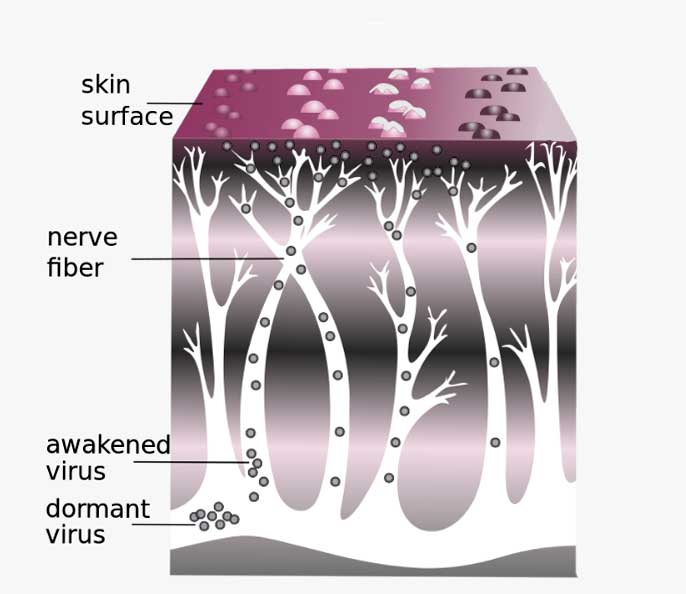Shingles herbs and natural remedies
Shingles is a virus that attacks the nerves. It is an acute central nervous system infection caused by herpes zoster virus (the same as chicken pox). Children, teenagers, and young adults can get shingles, but most people who have outbreaks are over 50 years old. Shingles are very painful.

Protect against shingles with herbs.
There are several herbal remedies that can help prevent, soothe, and heal shingles. Licorice, echinacea, and flax seed oil may help if taken regularly. Try taking flax seed oil daily, echinacea every other day, and licorice once a week.
Medicinal herbs that help protect and heal the nerves also help shingles. Some of the most well known and readily available are:
Take these herbs in teas or capsule form, plus add red clover to salads and nettle to soups!

Homemade herbal creams and herbal ointments for shingles
Shingles blisters can be treated with herbal teas, ointments, washes, and compresses. Herbs useful as a topical application to blisters include lemon balm, echinacea, aloe vera, golden seal, yellowroot, hyssop, oregano, peppermint, rosemary, sage, thyme, and calendula.
Rosemary essential oil, bergamot essential oil, hyssop essential oil, oregano essential oil may also be used in the fight against shingles. These herbs and essential oils may be incorporated into cream or ointment. They may also be used in water as a wash or compress.
For extra strength add oil from a vitamin E gel cap. Apply with a cotton ball at least three times a day. Do not take essential oils internally.
Symptoms of shingles include rash with blisters.
Symptoms include an eruption of blisters on the trunk of the body, usually along a peripheral nerve, with fever, itching, weakness, chills, and sometimes nausea. Uncomfortable feelings usually continue even after blisters are gone.
Fever blisters are also caused by a variation of the herpes virus. Read more about cold sores here.
Shingles occurs in people who had chickenpox earlier in life.
After a person recovers from chickenpox, the virus stays dormant in the body. The virus can reactivate years later, causing shingles.
Why does the virus become active after 20 or 30 years? The most common cause is probably a reaction to medication.
Other possible causes include stress, food allergies (especially dairy, shell fish, wheat, and MSG), food additives, preservatives, over chlorinated water, adrenal or liver exhaustion, histamine reaction, poor circulation, constipation, and high doses of caffeine.
Shingles can be a very painful condition but medicinal herbs do help!
The science of herpes
Herpes simples viruses are highly contagious, double stranded DNA viruses that cause reoccurring sores and blisters called outbreaks.
The virus affects all age groups, has no seasonal preference, and can infect both humans and animals.
The herpes virus establishes a life long infection that can be dormant for years, then suddenly reappears.
Things that cause outbreaks include stress, fatigue, physical trauma, unbalanced hormones, immuno-suppression, menstruation, fever, and lung problems.
The virus can spread when no symptoms are present, making it hard to contain.

Herpes is categorized into two types, type 1 and type 2.
Both can cause oral and genital lesions, although type 1 mainly occurs around the mouth and type 2 in the genital or anal areas.
Genital herpes can also be passed from mother to infant during childbirth.
Symptoms of herpes include a burning sensation, blisters, ulcers, and pain. There may also be a sore throat, fever, cervical lymph node swelling, headache, and fatigue.
Serious complications include meningitis, encephalitis, neonatal infection, and eye inflammation.
There is no cure and long time use of prescription treatments leads to drug resistance. Non-pharmaceutical remedies such as zinc, vitamin C, lysine, and a low arginine is beneficial, but results are inconsistent.
During tests, a combination of lysine, zinc oxide, echinacea, and goldenseal root cleared up lesions within a three day period.
Hundreds of herbs from around the world have been tested for use against the herpes virus, in animals and humans.
While herpes is not fatal, it is recurrent and can negatively affect a person's quality of life.
Plants may be the answer since they are less likely to develop resistance.
Herbs work by targeting viral attachment, penetration, DNA replication, gene expression, and by actually inactivating the virus.
A combination of herbs seems to work better than just one by itself. More research is needed in this area.
Scientific studies on herpes and herbal remedies
Studies in Iran show that several herbs are effective against herpes virus including lemon balm, Quercus persica (a type of oak tree), crown vetch, gray mangrove, aloe vera, green tea, and hyssop.
All of these herbs have biologically active, small molecules that can be absorbed and metabolized in the body. They are readily available and inexpensive.
Lysine may protect against shingles.
The essential amino acid lysine is known to reduce the severity of shingles outbreaks. Foods that contain a significant amount of lysine include legumes, watercress, soybeans, carob, spinach, meat, eggs, fish, and cheese (especially parmesan).
Cayenne pepper helps fight pain from shingles.
Cayenne pepper is also known to reduce the pain from shingles. Cayenne should be taken in capsule form, added to food, and applied as cream.
Powdered red pepper can be mixed into any body lotion or moisturizing cream. Apply to blisters several times a day. Test first on a small area of skin. If irritation or pain becomes worse, discontinue use.
Capsaicin compounds in the pepper bring relief by blocking pain signals from nerves just under the skin. Do not get cayenne pepper in the eyes or on mucus membranes.
Ice compresses can help stop shingles' pain.
Pain may also be controlled with ice compresses and Epsom salt baths. Also, fifteen minutes of early morning sunshine can work wonders.

Control shingles outbreaks with diet.
People with shingles should avoid antibiotics, penicillin, tetracycline, aspirin, and Tylenol. They should go on a cleansing diet to help alkalize the system.
Organic carrot juice, rose hip tea, apple juice, celery, beets, cucumbers, cabbage, and natural cranberry juice should be consumed daily during healing.
Patients with shingles should avoid acid forming foods including fried foods, salt, and soft drinks. They should also avoid refined foods high in sugar content.
To be on the safe side, people with shingles should also limit all artificial flavorings, nitrates (bacon and processed meats), and food colorings.
*Keep any remedy containing red pepper away from the eyes and other sensitive areas. Always consult with a healthcare professional before using any herbal remedy.
Sources:
https://www.ncbi.nlm.nih.gov/pmc/articles/PMC5052413/
https://www.ncbi.nlm.nih.gov/pmc/articles/PMC7894602/
Blessings to you and yours!
Thanks so much for reading my blog. Jan.

*Note - the information on this website has not been evaluated by the Food and Drug Administration.
© 2005-2024 website design and content by Janice Boling